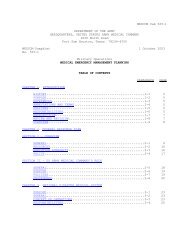(MCD) Guidelines
(MCD) Guidelines
(MCD) Guidelines
Create successful ePaper yourself
Turn your PDF publications into a flip-book with our unique Google optimized e-Paper software.
<strong>Guidelines</strong> for Military Mass Casualty Decontamination Operations<br />
During a Domestic HAZMAT/Weapon of Mass Destruction Incident<br />
PREFACE<br />
About these Mass Casualty<br />
Decontamination (<strong>MCD</strong>) <strong>Guidelines</strong><br />
These <strong>Guidelines</strong> provide key information to military personnel who support civil<br />
authorities in a domestic incident involving hazardous materials (HAZMAT) and/or<br />
weapons of mass destruction (WMD). They address concepts, principles, and<br />
fundamentals for support to domestic agencies during HAZMAT/WMD incidents<br />
using common language. These <strong>Guidelines</strong> were developed using the most current<br />
policy, guidance, and tactics, techniques, and procedures, and accepted best<br />
practices and lessons learned from key military, federal, state, and civilian<br />
authorities.<br />
This document is designed to assist in bridging the gap between military and civilian<br />
personnel. It provides a direct comparison between the <strong>MCD</strong> principles,<br />
decontamination equipment, and language used by military and civilian personnel.<br />
Special features to these guidelines include:<br />
• Best practices and lessons learned from <strong>MCD</strong> exercises and responses.<br />
• Detailed steps and techniques for conducting <strong>MCD</strong> operations under various<br />
conditions, including variations in the hazard, time, number of casualties,<br />
environment, and available equipment, supplies, and human resources.<br />
• Text boxes identifying common military and civilian <strong>MCD</strong> tasks in key doctrine.<br />
• A cross-reference guide showing similarities and differences between military and<br />
civilian <strong>MCD</strong> equipment.<br />
• Clarification of military and civilian terminology regarding <strong>MCD</strong> operations.<br />
These <strong>Guidelines</strong> are formatted to allow the user to tab between the 15 different<br />
sections. Sections 1.0 – 9.0 focus on <strong>MCD</strong> operations and appendices A – G contain<br />
supporting information. Appendix A contains the references that are cited in these<br />
<strong>Guidelines</strong>, including each appendix. Appendix B and Appendix C contain the<br />
acronym list and glossary, respectively. Appendix D contains the cross-reference<br />
guide that compares military and civilian <strong>MCD</strong> equipment. Appendix E contains<br />
information related to chemical, biological, and radiological agents and detection<br />
equipment. Appendix F contains decision tree matrices and checklists. Appendix G<br />
contains U.S. Army North <strong>MCD</strong> operational requirements and associated external<br />
evaluation standards.<br />
These <strong>Guidelines</strong> use the term “casualty” instead of “victim” or “patient.” However,<br />
cited references may use the terms “victim” and/or “patient.” These terms will not be<br />
changed to “casualty” when quotes are taken from the cited references. Generally,<br />
“casualty,” “victim,” and “patient” can be used interchangeably. The term “mass<br />
decontamination” is referring to a type of decontamination conducted within the<br />
overall <strong>MCD</strong> process itself.<br />
vi Original



